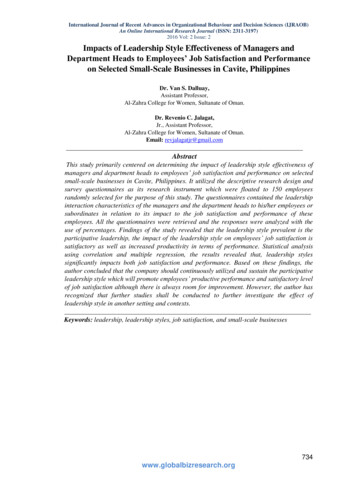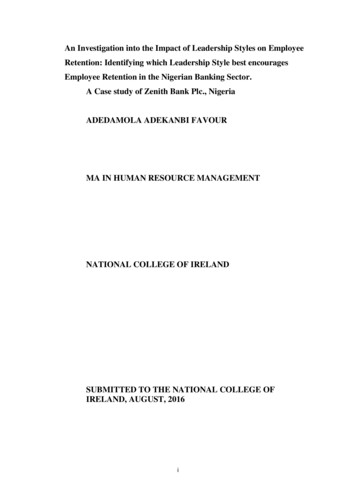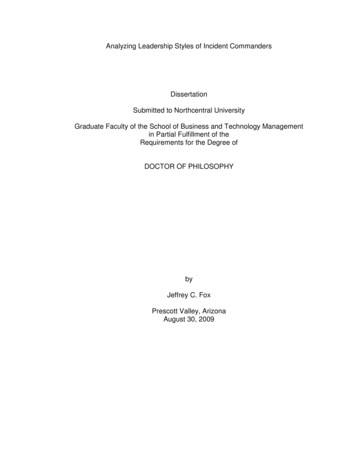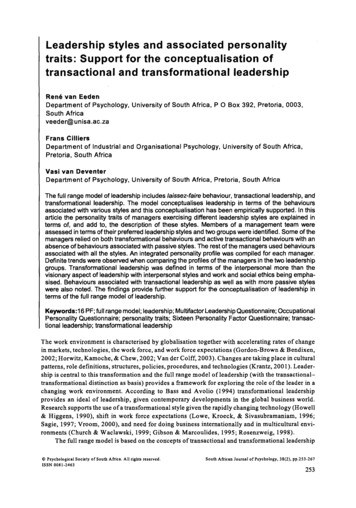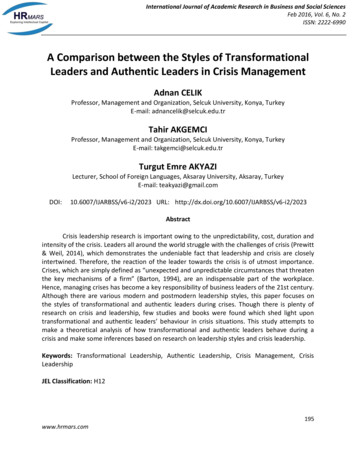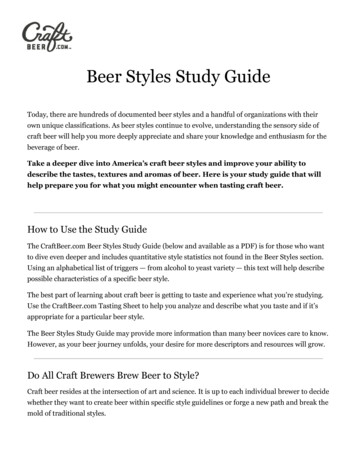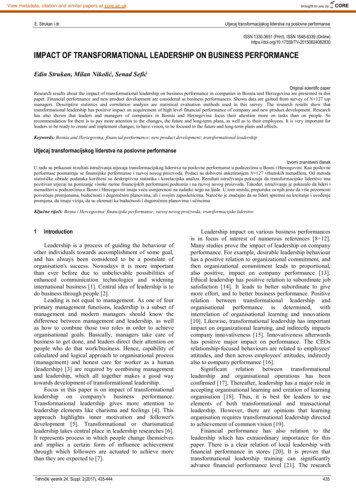
Transcription
THE IMPACT OF LEADERSHIP STYLES ON EMPLOYEE ENGAGEMENT INA LARGE RETAIL ORGANISATION IN THE WESTERN CAPEWENDY OLIVERMini-thesis submitted in partial fulfillment of the requirements for the degree ofMagister Commercii in the Department of Industrial Psychology, Faculty ofEconomic and Management Science, University of the Western CapeSUPERVISOR: RUKHSANA JANONOVEMBER 2012
DECLARATIONI hereby declare that the “The impact of leadership styles on employee engagement in alarge retail organisation in the Western Cape” is my own work, that it has not beensubmitted for any degree or examination at any other institution of higher learning andthat all the sources I have used or quoted have been indicated and acknowledged bycomplete references. It is being submitted for the degree of Magister Commercii at theUniversity of the Western Cape.Full Name:Wendy OliverDate:November 2012Signed: i
ACKNOWLEDGMENTSTo the one and only God, Jesus Christ, thank you for your grace and loving-kindness thathas carried me through a challenging year. The completion of this thesis would not havebeen possible without your daily strength. You are the Oasis of my life.To my dear parents, Donald and Glenda Oliver, thank you for believing in me and alwayscheering me on in life. Your love and support has made me the person that I am. Yourwisdom and sacrifice to educate me will carry on for generations to come.Then, to the special ladies in my life that have carried me in their prayers namely, SandyCorneilse, Candice Booysen and Abigail Milton, you are undeniably worthy of beingmentioned. My brother, Lindsay Oliver, the rest of my family, all my friends andsupportive colleagues, you are loved.To my supervisor, Rukhsana Jano, for your expert guidance and support, thanks forencouraging me to complete this thesis.To Karl Heslop, for believing in my ability and being a voice when it was most needed,you are a blessing to us all.Lastly, a big thank you to the HR Department of this organisation for the consent grantedto conduct the research and for all the respondents that kindly participated.ii
ABSTRACTIn today’s ever-changing, globally-competitive and volatile market, leadership isprobably one of the most significant contributors that determine the success or failure ofan organisation. Fundamental to this, is the way in which leaders are able to engage theiremployees. Employee engagement has therefore emerged as a critical topic which can bedefined as a positive and fulfilling work-related state of mind characterized by vigour,dedication and absorption (Schaufeli & Bakker, 2004). Research indicates its significanceto positive work outcomes such as high productivity levels, increased job satisfaction,low turnover and overall improved business results that all ultimately contributes towardbottom line (Harter, Schmidt & Hayes, 2002).To gain further insight, the purpose of this study was to investigate the impact ofleadership styles, particularly the impact of transformational and transactional leadershipon employee engagement. Within a business context, transformational leaders are those“extraordinary” individuals that have the ability to capture their employees’ attention,intellectually stimulate them and strategically align them with the vision and mission ofthe organisation. Contrary to this, is transactional leadership which is basically anexchange relationship between the leader and employee whereby the leader exchangesrewards and/or incentives for performance. Both styles of leadership are instrumental inengaging employees within the organisation, although a plethora of literature suggeststhat transformational leadership impacts more significantly on employee engagement(Schaufeli & Bakker, 2004).iii
For this study a quantitative research design was applied using a sample of 104employees in a retail organisation that all had someone they reported to. Participants wererequested to complete the Multifactor Leadership Questionnaire, the Utrecht WorkEngagement Scale and a biographical questionnaire. Pearson correlations were computedto investigate the relationship between the variables.Results indicate that there is a statistically significant relationship between bothleadership styles and the overall dimensions of employee engagement (namely, vigour,dedication and absorption). Transactional leadership however, did not have a positiveinfluence on vigour. Comparing the two leadership styles, transformational leadershipplayed a greater role in predicting employee engagement as opposed to transactionalleadership.In light of the above, this study added to existing literature by providing insight into thestrength and direction of relationships amongst these variables. Furthermore, it alsoprovides valuable information for organisational leaders seeking to engage theiremployees. Limitations and recommendations of this study also present insights into thepossibilities that could be explored for future research.KEY WORDSTransformational leadership, transactional leadership, employee engagement, vigour,dedication, absorption,inspirational motivation, idealised influence, individualconsideration, intellectual stimulationiv
LIST OF FIGURESFigure 2.1Basic Leadership Approaches13Figure 2.2Studies of Leadership Traits and Characteristics as15Postulated by Various ResearchersFigure 2.3Maslow’s Hierarchy of Needs24Figure 4.1Gender of Respondents77Figure 4.2Age of Respondents78Figure 4.3Race of Respondents79Figure 4.4Education Level of Respondents80Figure 4.5Tenure of Respondents81Figure 4.6Type of Employment82Figure 4.7Job Title of Respondents83Figure 4.9Dimensions of Work Engagement85v
LIST OF TABLESTable 4.1Means, Standard Deviation, Minimum and Maximum84Scores for the Dimensions of Employee EngagementTable 4.2Pearson’s Correlation Matrix between the Dimensions86of Work Engagement and Transformational LeadershipTable 4.3Pearson’s Correlation Matrix between the Dimensions of87Work Engagement and Transactional LeadershipTable 4.4Stepwise Regression for Work Engagement, Transactional88and Transformational LeadershipTable 4.5Cronbach’s Coefficient Alpha for the Dimensions of theUWES Questionnaire as well as for the MLQvi89
TABLE OF CONTENTSPAGE NODeclarationiAcknowledgmentsiiAbstractiiiList of FiguresvList of TablesviCHAPTER 1: INTRODUCTION AND PROBLEM STATEMENT1.1Introduction11.2Motivation for the Study41.3Research Objectives61.4Research Hypotheses71.5Definition of Constructs71.5.1Transformational Leadership71.5.2Transactional Leadership81.5.3Employee Engagement81.6Summary of the Chapter91.7Overview of the Study9CHAPTER 2: LITERATURE REVIEW2.1Introduction112.2Leadership Defined12
2.3Leadership Theories132.3.1Trait Theory142.3.2Behavioural Theory162.3.2.1Ohio State and University of Michigan Models172.3.2.2Blake and Mouton’s Managerial Grid182.3.2.3Theory X and Theory Y182.3.3Contingency Theory192.3.3.1Fiedler’s Contingency Model202.3.3.2Hersey and Blanchard’s Situational Leadership Model202.3.3.3House’s Path-Goal Model222.3.3.4Leader-Member Exchange Theory222.4Full Range Leadership Approach232.4.1Transformational Leadership Defined232.4.1.1Benefits of Transformational Leadership282.4.1.2Limitations of Transformational Leadership302.4.2Transactional Leadership Defined312.4.2.1Benefits of Transactional Leadership342.4.2.2Limitations of Transactional Leadership342.5Authentic Leadership362.6Servant Leadership382.7Employee Engagement Defined402.8The Importance of Employee Engagement432.9Drivers of Employee Engagement45
2.9.1Meaning at Work and its affect on Employee Engagement462.9.2Organisational Cultures and its affect on Employee48Engagement2.9.2.1Hierarchy Culture482.9.2.2Market Culture492.9.2.3Clan Culture502.9.2.4Adhocracy Culture512.9.3Decision-Making and its affect on Employee Engagement522.10Significance of Employee Engagement522.11The Cost of Disengagement542.12Linking Transformational Leadership to Employee55EngagementCHAPTER 3: RESEARCH METHODOLOGY3.1Introduction593.2Research Design593.2.1Sampling Method593.3Population and Sample Size603.3.1Population603.3.2Sample603.4Procedure for Data Gathering613.5Measuring Instruments623.5.1Biographical Questionnaire62
3.5.2Multifactor Leadership Questionnaire (MLQ)633.5.2.1Nature and Composition633.5.2.2Reliability and Validity653.5.2.2.1Reliability of MLQ653.5.2.2.2Validity of MLQ673.5.2.3Rationale for Inclusion673.5.3Utrecht Work Engagement Scale (UWES)673.5.3.1Nature and Composition683.5.3.2Reliability of UWES693.5.3.3Validity of UWES703.5.3.4Rationale for Inclusion713.6Statistical Techniques723.7Descriptive Statistics723.8Inferential Statistics733.9Pearson’s Product Moment Correlation Coefficient733.10Summary of the Chapter74CHAPTER 4: PRESENTATION OF RESULTS4.1Introduction754.2Descriptive Statistics764.2.1Biographical Characteristics774.2.2.Descriptive Statistics844.2.2.1Measures of Central Tendency and Dispersion844.3Inferential Statistics86
4.4Reliability Analysis894.5Conclusion90CHAPTER 5: DISCUSSION OF RESULTS, CONCLUSIONS : 1915.1.2Hypothesis: 2975.1.3Hypothesis: 31005.2Limitations and Recommendations for Future Research1045.3Recommendations for the Organisation1065.4Conclusion108REFERENCE LIST109
CHAPTER 1INTRODUCTION AND PROBLEM STATEMENT1.1INTRODUCTIONThe study of leadership and its impact on employee engagement is becoming increasinglyessential if organisations want to gain and sustain a competitive advantage in today’sglobal economy (Macey & Schneider, 2008). Having an engaged workforce is vital asresearch indicates that engaged employees help organisations reap benefits such asincreased efficiency, higher levels of customer satisfaction, higher productivity and lowerturnover rates (Buhler, 2006).Leadership has been singled out as a concept that has attracted the attention of manyscholars over the past years. It is one of the most studied fields in the social sciences andcarries weight in every walk of life related to business, politics, education and religionetcetera. According to Bass (1990, p. 11), “there are almost as many different definitionsof leadership as there are persons who have attempted to define the concept.” Leadershipis therefore a complex construct that cannot be defined in two or three lines. Despitevarious definitions, the theoretical basis of leadership is that it is a process whereby oneindividual has the ability to influence a group of individuals to achieve a common goal.Kouzes and Posner (2007) describe it as an interaction between two or more people thatresult in some kind of action leading to an output to satisfy a set agreement or criteria.1
In the past, leadership approaches ranged from the trait to behavioural to the situationaltheory, also known as the contingency theory (Bass & Riggio, 2006). The trait approachsuggested that leaders were special people born with certain social traits that made themgreat leaders (Mann, 1959; Stogdill, 1948), the behavioural approach assessed leadershipin relation to the way an individual behaved (Blake & Mouton, 1964) and the situationalapproach focused on looking at the leader in conjunction to situational factors beforedetermining whether an individual was a leader or not (Fiedler, 1967; Hersey &Blanchard, 1977).The focus of leadership research had however, made a great shift to the full rangeleadership approach which is now recognized as the most suitable style of leadership incontemporary organisations of the 21st century (Bass & Riggio, 2006). This theoryencompasses three leadership dimensions namely, transformational, transactional andlaissez-faire leadership styles. Essentially, transformational leaders are known tostimulate followers to go beyond their own self-interest and instead work toward thegreater good of the organisation. They do this by positively influencing their employees’motivational, morality and empowerment levels. Transactional leaders monitor andcontrol employees through economic means based on their performance and laissez-faireleaders are known to relinquish all power and use no particular leadership style to leadtheir employees (Bakker, Demerouti & Schaufeli, 2003). Organisational leaders,particularly those that practice a transformational leadership style, have the remarkableability to motivate and encourage employees to be and give their best. These leaderspositively influence their employees to work toward reaching the established vision and2
objectives of the business (Nortje, 2010). Managers and supervisors that endorsetransformational leadership styles are therefore those that will cause fundamental stepchanges and shift paradigms in order to drive the business forward. Transformationalleadership is therefore crucial for advancing organisations as these leaders inspireemployees towards the vision and role model the attitude and behaviours expected ofemployees (Nortje, 2010).Employee engagement is an important concept for organisations because it predictsproductivity, job satisfaction, motivation, commitment and low turnover intention(Bakker, Demerouti et. al., 2003; Bakker, Schaufeli, Leiter & Taris, 2008). According toNortje (2010, p. 19), “the Corporate Leadership Council defines employee engagement asthe extent to which employees commit to something or someone in the organisation, howhard they work as a result of this commitment and how long they intend to stay within anorganisation.” Employee engagement can also be postulated as “a positive, fulfilling,work-related state of mind that is characterised by vigour, dedication and absorption”according to Schaufeli, Salanova, González-Romá and Bakker (2002, p. 74).With globalisation, unpredictable economic trends and customer needs that arecontinually changing, talent managing and retaining employees have become extremelychallenging over the past decade. Diverse workforces with Generation Y, Generation Xand Baby Boomers all active in the organisation concurrently with various values, beliefsystems and expectations of success also make the engagement of employees morecomplex. Leaders therefore have a huge role in motivating and encouraging these3
employees to be and give their best. Subsequently, leadership must be recognized as avital component in the effective management of employees (Liu, Lepak, Takeuchi, &Sims, 2003) as it is one of the single biggest elements contributing to employeeengagement in the workplace (Macey & Schneider, 2008; Wang & Walumbwa, 2007).Studies show that transformational leadership is positively related to work engagementand that it is these leaders that are able to motivate employees to become more engrossedin their work. As a result this leads to higher levels of job satisfaction, commitment ofemployees and increased productivity within organisations. Understanding leadership andits impact on the engagement of employees has therefore become of utmost importanceirrespective of management/supervisory levels as it has been found that even first-linesupervisors within an organisation will directly affect the engagement of its employees(Gibbons, 2006).1.2MOTIVATION FOR THE STUDYThe value proposition of this organisation is being able to offer customers the widestrange of branded products at very competitive prices as they operate on a high-volumelow-cost model. Operating on a national scale in more than 120 stores, this organisationacknowledges customers to be the lifeblood of their business and therefore strives to offerexcellent customer service through effective leadership with passionate and engagedemployees. In all studies of drivers of engagement, studies unequivocally postulate thatnobody impacts the state of engagement more that the employee’s immediate leader(Nortje, 2010). The most important contributor to the feelings of employee engagement is4
based on the relationship that employees have with their first-line managers. Managersthat are able to form and maintain meaningful relationships with their employees andemotionally connect employees to their organisations by showing them the link betweenwhat they do and how they significantly impact the organisation is critical for engagingemployees. When first-line managers are able to emphasize the significant connectionbetween an employee’s key responsible areas and the organisation’s strategy, employeesfeel that their work is truly of value, not only to themselves but also to their peers,managers and the organisation itself. This often leads to greater levels of job satisfaction,psychological commitment and emotional engagement (Nortje, 2010). These factors willconsequently positively influence the service offerings within this organisation.Dvir, Eden, Avolio and Shamir (2002) scientifically tested the effect that leaders have ontheir followers. In relation to leadership styles, they found that it was transformationalleaders that had a direct effect on their follower’s sense of awareness and fulfillmentlevels as these leaders sought to stimulate and please the higher-order needs of people.Olivier and Rothmann (2007) purport that it is transformational leadership approaches inan organisation that will grow and enhance employee engagement as employees areencouraged to generate innovative ideas and are given the platform to freely expressthemselves giving them a strong sense of empowerment.As this organisation is a retailer with a large market share, it is critical that strategicleaders, managers (from senior to junior levels) and employees are engaged as it has beenproven that highly engaged employees are those that make substantive contributions in5
their workplaces (Lockwood, 2007). When employees are engaged, they feel part of theirorganisation which therefore increases their sense of belonging, trust levels and selfidentity. This identity and association with the organisation therefore developscommitment in employees and increases their performance (Lockwood, 2007).It is envisaged that these findings will assist directors, executives and all managers inraising an awareness of the most dominant perceived leadership styles specificallypracticed by managers in this particular organisation and in so doing assist them inunderstanding how leadership styles could affect the current levels of engagement of theiremployees, which in turn, could also impact on aspects such as customer service,organisational effectiveness and productivity within their business.1.3RESEARCH OBJECTIVESThe primary objective of this study is to determine the impact of leadership styles(namely, transformational leadership and transactional leadership) on employeeengagement.More specifically, it aims to determine whether: Transformational leadership will influence levels of employee engagement; Transactional leadership will influence levels of employee engagement and Transformational leadership will raise levels of engagement more so thantransactional leadership.6
1.4RESEARCH HYPOTHESESThe following hypotheses will therefore be investigated:H1:There is a statistically significant relationship between transformationalleadership and the overall dimensions of employee engagement.H2:There is a statistically significant relationship between transactional leadershipand the overall dimensions of employee engagement.H3:Transformational leadership is more likely to increase the levels of employeeengagement as opposed to transactional leadership.1.5DEFINITION OF CONSTRUCTSThe important constructs being investigated are briefly defined:1.5.1TRANSFORMATIONAL LEADERSHIPTransformational leadership behaviours are said to be influential in motivating employeechange and transforming them to be more aware of task outcomes, activating theirhighest order needs and stretching them beyond their own self-interest for the benefit ofthe organisation (Bass & Avolio, 1990; Bassi & McMurrer 2007). Usually this type ofleadership is demonstrated to a greater degree at the top levels of an organisation as7
transformational leaders are able to serve as exemplary role models, articulating businessgoals and providing the emotional appeal, meaning and challenge to employees in orderto get the work done with enthusiasm and commitment through their employees(Demerouti, Bakker, de Jonge, Janssen & Schaufeli, 2001). Inspirational motivation,idealised influence, individual consideration and intellectual stimulation are the keydimensions of transformational leadership (Avolio, Zhu, Koh & Bhatia, 2004).1.5.2TRANSACTIONAL LEADERSHIPTransactional leadership in its purest form is an exchange of valued things between theleader and follower in order to achieve an outcome. It has always been viewed as themethod of getting subordinates to meet job requirements by reinforcing rewards orpunishments (Avery, 2004; Bass, 1985). In other words, if followers do something goodthen they will be rewarded and if followers do something wrong then they will bepunished. Transactional leaders will therefore identify, define and communicate whatneeds to be done and how the instruction will be carried out (Piccolo & Calquitt, 2006).The transactional dimensions of leadership, as determined by Bass and Avolio (1996), aresummarized by the following approaches, namely, management by exception (passiveand active), constructive transaction/contingent reward and the laissez faire style.1.5.3EMPLOYEE ENGAGEMENTEmployee engagement is defined as “a heightened emotional and intellectual connectionthat an employee has for his/her job, organisation, manager, or co-workers that, in turn,8
influences him/her to apply additional discretionary effort to his/her work” (Gibbons,2006, p. 5).1.6SUMMARY OF THE CHAPTERIn this chapter an overview of the background to and motivation for the study wasdiscussed. Furthermore, the research questions, hypotheses and definition of importantconstructs were highlighted.1.7OVERVIEW OF THE STUDYChapter 2 will give an overview of the theoretical background of the two variables beingstudied namely, leadership and employee engagement.Chapter 3 will address the research design and methodology utilized to investigate theresearch problem. Specifically, the sampling design, measuring instruments used togather the data and statistical techniques that will be utilized to test the hypotheses will bedepicted.Chapter 4 will provide a presentation of the analysis and research findings obtained fromthe empirical analysis.Chapter 5 will discuss the most significant results of the previous chapter. Based on theresults, inferences will be drawn and incorporated with existing literature. Furthermore,9
limitations and practical implications of the research findings will be highlighted andrecommendations for future research will be made.The ensuing chapter will provide a literature review of the variables being investigatednamely, transformational leadership, transactional leadership and employee engagement.10
CHAPTER 2LITERATURE REVIEW2.1INTRODUCTIONOrganisational leaders are tasked to cope with many challenges resulting fromglobalisation, economic turmoil, volatile business markets, continuous consumerchanging needs and complex technology impacting the commercial industry (Masood,Dani, Burns & Backhouse, 2006). The skill of leading the most valued asset of anycompany, that is, its human capital or better known as the “employee”, has without adoubt become more challenging in these turbulent times. Leadership and its role increating and sustaining a culture of engaged employees within the workplace is thereforeof utmost importance as organisational leaders begin to understand how the outcome ofemployees’ discretionary effort drives organisational performance, such as increasedproductivity, profit, customer loyalty and shareholder return (Hewitt Associates, 2005).Avery (2004) postulates that leadership is the most studied but the least understood topicin the social sciences. This in all probability is due to scholars having different conceptsin mind. Despite the abundance of writing on this subject, it has presented a majorchallenge to researchers interested in understanding the nature of leadership as it is aphenomenon adding significant value to the body of research but can also be viewed as ahighly complex concept to understand.One of the biggest challenges facing the study of leadership is that there is no one agreeddefinition, as underlying concepts often change and have changed over the course of time11
(Avery, 2004). Yukl (2002) also confirms with Bass (1990) that there are almost as manydefinitions of leadership as there are persons who have attempted to define the concept.Despite all the research conducted on leadership, it is essentially about one individualinfluencing the behaviour of another.2.2LEADERSHIP DEFINEDBurns (1978) initially described leadership as individuals inducing others to act towardcertain goals that represent the values and motivations, the wants and needs, theaspirations and expectations of both leaders and followers. Bass (1990, p. 11) definesleadership as “the focus of group processes, as a matter of personality, as a matter ofincluding compliance, as the exercise of influence, as particular behaviours, as a form ofpersuasion, as a power relation, as an instrument to achieve goals, as an effect ofinteraction, as a differentiated role, as initiation of structure and as many combinations ofthese definitions.” Nelson (cited in De Lacy, 2009) termed it as the process of guidingand directing the behaviour of people in the work environment. Yukl (2002) contendsleadership to be the process of influencing others to understand and agree about whatneeds to be done, how it can be done effectively and the process of facilitating individualand collective efforts to accomplish shared objectives. Gregoire and Arendt (2004)viewed leadership as the behaviour of an individual directing the activities of a grouptowards a shared goal.Piccolo and Colquitt (2006) hypothesized it as the exercise of influence by one memberof a group or organisation over other members to help the group or organisation achieve12
its goals. Lastly, it is also described as “the art or process of influencing people so thatthey will strive willingly and enthusiastically toward the achievement of group goals”according to Koontz and Weihrich (2008, p. 311).2.3LEADERSHIP THEORIESGiven the plethora of leadership literature available, its theories are best outlined within atheoretical framework as depicted in Figure 2.1 below. Leadership theory can becategorized into four main schools namely, the Trait approach, Behavioural approach,Contingency approach and the Full Range approach each of which will be discussed inmore detail.Figure 2.1: Basic leadership approachesLEADERSHIP THEORIESTRAIT APPROACHBEHAVIOURALAPPROACH Stogdill (1948) McGregor’s Theory Mann (1959) Theory of Lewin,Lippit and White Stogdill (1974) Lord, DeVader & Allinger Managerial GridHersey and Blanchard’sSituational leadership Michigan Models Kirkpatrick & Locke (1991)Fiedler’s ContingencyModelOhio State andUniversity of(1986)CONTINGENCYAPPROACHHouse’s Path-GoalModel Leader-MemberExchange: TheoryX and YNEW APPROACHFULL RANGE LEADERSHIPSource: Adapted from Amos and Ristow (1999)13
2.3.1TRAIT THEORYMost literature refers to the trait theory as the earliest approach to studying leadership.The trait school of thinking assumes that leaders are born and not made. According toBass (1981), there are certain physical, social and personal characteristics that areinherent in certain individuals which ultimately makes the difference between leaders andnon-leaders. According to Yukl (2002, p. 175), the term trait refers to “a variety ofindividual attributes, including aspects of personality, temperament, needs, motives, andvalues.” Examples could include self-confidence, extroversion, emotional maturity andhigh energy levels. Yukl (2002) believes that these are all characteristics that areparticularly suited to leadership, amongst others and that people who make good leaderswill have ample combination of these traits.This approach suggest that certain people are born with social traits which make themgreat leaders and the theory further explains which traits actually made certain peoplegreat leaders, albeit on the business, social, political or military front. Researchers wereas a result tasked with identifying a universal set of traits inherent of all leaders in orderto set them apart from non-leaders (Bass, 1990). Figure 2.2 below presents a summary ofthe confirmed traits and characteristics that trait approach researchers identified leadersshould possess (Northouse, 2004).14
Figure 2.2: Studies of leadership traits and characteristics as postulated by variousresearchersStogdill (1948)Mann (1959)Stogdill(1974)Lord, DeVader &Allinger(1986)Kirkpatrick&Locke(1991) Intelligence Intelligence Achievement Intelligence Drive Alertness Masculinity Persistence Masculinity Motivation Initiative Adjustment Insight Dominance Integrity Persistence Dominance Initiative Confidence Confidence Extroversion Confidence Cognitive ability Sociability Conservatism Responsibility Tolerance Influence SociabilitySource: Northouse (2004)Researchers such as Stogdill (1974) investigated the role of traits in leadership behaviour.The aim of his approach was to provide evidence that certain characteristics intrinsic inindividuals resulted in effective leadership. He however, could not provide a consistentset of traits that differentiated leaders from non-leaders and this approach was thereforeheavily criticized as there were no consistent set of traits to differentiate between the two.Several researchers therefore questioned the basic premise of a “unique set of traits” thatdefined leadership and subsequently shifted their attention to study the behaviour of15
leaders within the context of work instead of focusing on leadership traits (Mester,Visser, Roodt & Kellerman, 2003).2.3.2BEHAVIOURAL THEORY
2.4 Full Range Leadership Approach 23 2.4.1 Transformational Leadership Defined 23 2.4.1.1 Benefits of Transformational Leadership 28 2.4.1.2 Limitations of Transformational Leadership 30 2.4.2 Transactional Leadership Defined 31 2.4.2.1 Benefits of Transactional Leadership 34




